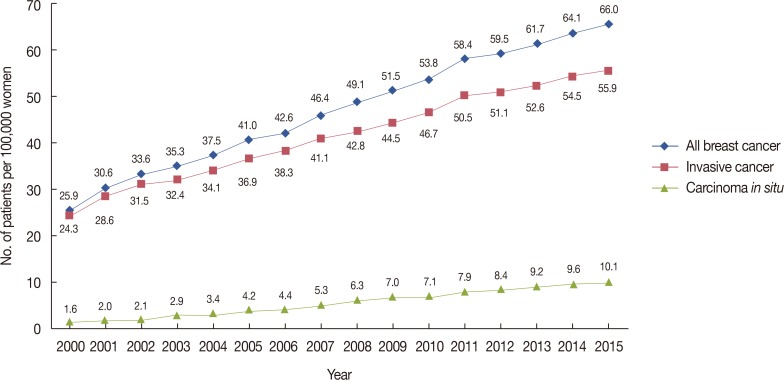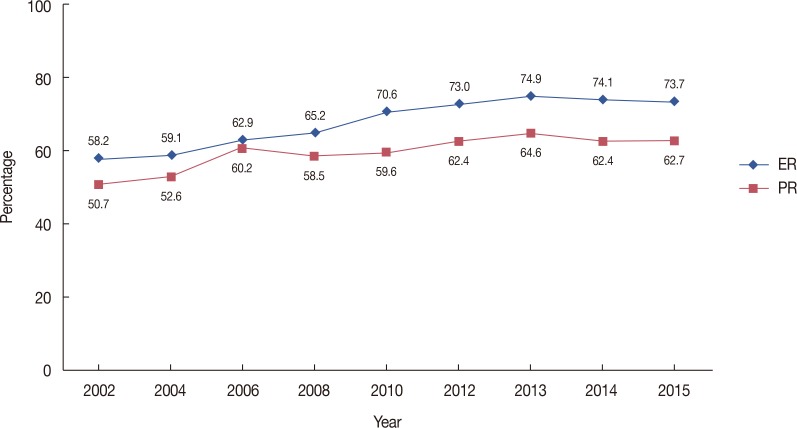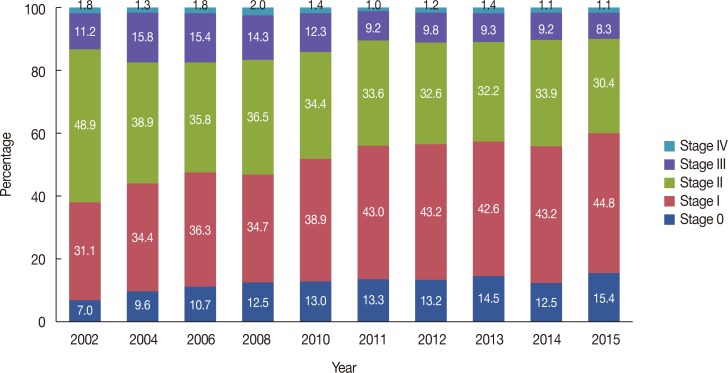Basic Findings Regarding Breast Cancer in Korea in 2015: Data from a Breast Cancer Registry
- Affiliations
-
- 1Department of Surgery, Research Institute of Clinical Medicine, Chonbuk National University Hospital, Chonbuk National University and Biomedical Research Institute, Jeonju, Korea. yhj0903@jbnu.ac.kr
- 2Department of Surgery, Chosun University Hospital, Chosun University College of Medicine, Gwangju, Korea.
- 3Department of Surgery, Soonchunhyang University Bucheon Hospital, Soonchunhyang University College of Medicine, Bucheon, Korea.
- 4Department of Surgery, Pusan National University Yangsan Hospital, Pusan National University School of Medicine, Busan, Korea.
- 5Division of Breast and Endocrine Surgery, Department of Surgery, Samsung Medical Center, Sungkyunkwan University School of Medicine, Seoul, Korea.
- 6The Korea Central Cancer Registry, Division of Cancer Registration and Surveillance, National Cancer Center, Goyang, Korea.
- KMID: 2441862
- DOI: http://doi.org/10.4048/jbc.2018.21.1.1
Abstract
- The Korean Breast Cancer Society (KBCS) has established a nationwide breast cancer database using an online registration program in 1996. The present study aimed to analyze the basic findings and trends of breast cancer in Korea in 2015 using the data provided by the Korea Central Cancer Registry and the KBCS. In 2015, a total of 22,550 patients were newly diagnosed with breast cancer, of which 3,331 were carcinoma in situ cases and 19,219 were invasive cancer cases. The incidence rate of breast cancer in Korea has steadily increased since the nationwide database was established, and the crude rate and age-standardized rate including that of carcinoma in situ, were 88.1 and 66.0 cases per 100,000 women, respectively. In terms of age, the incidence of breast cancer was the highest in the 40-49-year-old age group (7,889 patients, 35.0%). With regard to surgical procedure, breast-conserving surgery was frequently performed (62.3%). However, the rate of mastectomy has been gradually increasing since 2012, that is, from 32.3% in 2014 to 36.1% in 2015. The rate of early breast cancer has continued to increase, and that of stages III and IV breast cancer was only 9.1% at the time of diagnosis. However, the 5-year survival rate of patients with carcinoma in situ from 2011 to 2015 was 92.3%, which was 14.4% higher than that from 1993 to 1995 (77.9%). Analysis of data from the nationwide registry of breast cancer will not only help to understand the characteristics of breast cancer in individuals in Korea, but will also significantly contribute to the treatment and research of breast cancer. Therefore, a high quality database for breast cancer in Korea must be established by further initiating registration project and establishing an objective legal basis.
Keyword
MeSH Terms
Figure
Cited by 7 articles
-
Gastric Complications after Adjuvant Radiotherapy for Breast Cancer
Won Kyung Cho, Doo Ho Choi, Won Park, Haeyoung Kim, Seonwoo Kim, Myung-Hee Shin, Hyejung Cha
J Breast Cancer. 2019;22(3):464-471. doi: 10.4048/jbc.2019.22.e42.Omission of Chemotherapy for the Treatment of Mucinous Breast Cancer: A Nationwide Study from the Korean Breast Cancer Society
Hyung Suk Kim, Jong Uk Lee, Tae Kyung Yoo, Byung Joo Chae, Donghee Son, Yun Jin Kim, Woo Chan Park
J Breast Cancer. 2019;22(4):599-612. doi: 10.4048/jbc.2019.22.e46.From Genetic Testing to Treatment and Prevention of BRCA-Related Breast Cancer
Chang-Seok Ki
Ann Lab Med. 2020;40(2):99-100. doi: 10.3343/alm.2020.40.2.99.An Updated Nomogram for Predicting Invasiveness in Preoperative Ductal Carcinoma In Situ of the Breast
Sanghwa Kim, Jihong Kim, Hyung Seok Park, Ha Yan Kim, Kwanbum Lee, Jeea Lee, Haemin Lee, Jee Ye Kim, Seung Il Kim, Young Up Cho, Byeong-Woo Park
Yonsei Med J. 2019;60(11):1028-1035. doi: 10.3349/ymj.2019.60.11.1028.유방암 환자에서 전단파 탄성초음파의 임상적 적용
Hyun Jo Youn, Sang Yull Kang, Sung Hoo Jung
J Surg Ultrasound. 2018;5(2):33-38. doi: 10.46268/jsu.2018.5.2.33.젊은 유방암 환자에서 수술 전 유방초음파와 자기공명영상의 종양 크기 측정 정확도 비교
Sang Yull Kang, Eun Jung Choi, Jung Hee Byon, Ha Rim Ahn, Hyun Jo Youn, Sung Hoo Jung
J Surg Ultrasound. 2020;7(1):7-13. doi: 10.46268/jsu.2020.7.1.7.Temporal Trend in Uptake of the National General Health Checkups and Cancer Screening Program among Korean Women with Breast Cancer
Thi Xuan Mai Tran, Soyeoun Kim, Chihwan Cha, Boyoung Park
Cancer Res Treat. 2024;56(2):522-530. doi: 10.4143/crt.2023.729.
Reference
-
1. Ferlay J, Soerjomataram I, Ervik M, Dikshit R, Eser S, Mathers C, et al. GLOBOCAN 2012 v1.0, cancer incidence and mortality worldwide: IARC CancerBase No. 11. International Agency for Research on Cancer;Accessed February 13th, 2018. http://globocan.iarc.fr.2. National Cancer Information Center. Ministry of Health and Welfare. Cancer statistics. Accessed February 13th, 2018. https://www.cancer.go.kr/.3. Lee KS, Chang HS, Lee SM, Park EC. Economic burden of cancer in Korea during 2000-2010. Cancer Res Treat. 2015; 47:387–398. PMID: 25672582.
Article4. Shin HR, Won YJ, Jung KW, Kong HJ, Yim SH, Lee JK, et al. Nationwide cancer incidence in Korea, 1999~2001: first result using the national cancer incidence database. Cancer Res Treat. 2005; 37:325–331. PMID: 19956367.
Article5. Fay MP, Tiwari RC, Feuer EJ, Zou Z. Estimating average annual percent change for disease rates without assuming constant change. Biometrics. 2006; 62:847–854. PMID: 16984328.
Article6. Kim HJ, Luo J, Chen HS, Green D, Buckman D, Byrne J, et al. Improved confidence interval for average annual percent change in trend analysis. Stat Med. 2017; 36:3059–3074. PMID: 28585245.
Article7. Kim Z, Min SY, Yoon CS, Jung KW, Ko BS, Kang E, et al. The basic facts of Korean breast cancer in 2012: results from a nationwide survey and breast cancer registry database. J Breast Cancer. 2015; 18:103–111. PMID: 26155285.
Article8. Min SY, Kim Z, Hur MH, Yoon CS, Park EH, Jung KW, et al. The basic facts of Korean breast cancer in 2013: results of a nationwide survey and breast cancer registry database. J Breast Cancer. 2016; 19:1–7. PMID: 27066090.
Article9. Park EH, Min SY, Kim Z, Yoon CS, Jung KW, Nam SJ, et al. Basic facts of breast cancer in Korea in 2014: the 10-year overall survival progress. J Breast Cancer. 2017; 20:1–11. PMID: 28382089.
Article10. Ferlay J, Soerjomataram I, Ervik M, Dikshit R, Eser S, Mathers C, et al. Cancer Incidence and Mortality Worldwide: IARC CancerBase No. 11. 2013. Lyon: International Agency for Research on Cancer;2014.11. Bhatia H. Breast cancer in Asia. Gen Re;Accessed February 4th, 2018. http://www.genre.com/knowledge/publications/ri16-4-en.html.12. DeSantis C, Ma J, Bryan L, Jemal A. Breast cancer statistics, 2013. CA Cancer J Clin. 2014; 64:52–62. PMID: 24114568.
Article13. Ernster VL, Ballard-Barbash R, Barlow WE, Zheng Y, Weaver DL, Cutter G, et al. Detection of ductal carcinoma in situ in women undergoing screening mammography. J Natl Cancer Inst. 2002; 94:1546–1554. PMID: 12381707.
Article14. National Cancer Institute. Cancer stat facts: female breast cancer. Accessed February 4th, 2018. https://seer.cancer.gov/statfacts/html/breast.html.15. Saika K, Sobue T. Epidemiology of breast cancer in Japan and the US. Japan Med Assoc J. 2009; 52:39–44.16. Zeng H, Zheng R, Zhang S, Zou X, Chen W. Female breast cancer statistics of 2010 in China: estimates based on data from 145 population-based cancer registries. J Thorac Dis. 2014; 6:466–470. PMID: 24822104.17. DeSantis C, Howlader N, Cronin KA, Jemal A. Breast cancer incidence rates in U.S. women are no longer declining. Cancer Epidemiol Biomarkers Prev. 2011; 20:733–739. PMID: 21357727.
Article18. Hammond ME, Hayes DF, Dowsett M, Allred DC, Hagerty KL, Badve S, et al. American Society of Clinical Oncology/College of American Pathologists guideline recommendations for immunohistochemical testing of estrogen and progesterone receptors in breast cancer (unabridged version). Arch Pathol Lab Med. 2010; 134:e48–e72. PMID: 20586616.19. Anderson WF, Rosenberg PS, Petito L, Katki HA, Ejlertsen B, Ewertz M, et al. Divergent estrogen receptor-positive and -negative breast cancer trends and etiologic heterogeneity in Denmark. Int J Cancer. 2013; 133:2201–2206. PMID: 23616071.
Article20. Yang XR, Chang-Claude J, Goode EL, Couch FJ, Nevanlinna H, Milne RL, et al. Associations of breast cancer risk factors with tumor subtypes: a pooled analysis from the Breast Cancer Association Consortium studies. J Natl Cancer Inst. 2011; 103:250–263. PMID: 21191117.21. Colditz GA, Rosner BA, Chen WY, Holmes MD, Hankinson SE. Risk factors for breast cancer according to estrogen and progesterone receptor status. J Natl Cancer Inst. 2004; 96:218–228. PMID: 14759989.
Article22. Fancellu A. Considerations arising from requests from patients for a bilateral mastectomy who are eligible for breast-conserving surgery: factors weighing for and against performing the operation. Oncol Lett. 2016; 12:764–766. PMID: 27347213.
Article23. Xia C, Schroeder MC, Weigel RJ, Sugg SL, Thomas A. Rate of contralateral prophylactic mastectomy is influenced by preoperative MRI recommendations. Ann Surg Oncol. 2014; 21:4133–4138. PMID: 24934585.
Article24. Heil J, Rauch G, Szabo AZ, Garcia-Etienne CA, Golatta M, Domschke C, et al. Breast cancer mastectomy trends between 2006 and 2010: association with magnetic resonance imaging, immediate breast reconstruction, and hospital volume. Ann Surg Oncol. 2013; 20:3839–3846. PMID: 23838917.
Article25. Miller BT, Abbott AM, Tuttle TM. The influence of preoperative MRI on breast cancer treatment. Ann Surg Oncol. 2012; 19:536–540. PMID: 21751044.
Article26. Fisher CS, Martin-Dunlap T, Ruppel MB, Gao F, Atkins J, Margenthaler JA. Fear of recurrence and perceived survival benefit are primary motivators for choosing mastectomy over breast-conservation therapy regardless of age. Ann Surg Oncol. 2012; 19:3246–3250. PMID: 22833001.
Article27. Mahmood U, Hanlon AL, Koshy M, Buras R, Chumsri S, Tkaczuk KH, et al. Increasing national mastectomy rates for the treatment of early stage breast cancer. Ann Surg Oncol. 2013; 20:1436–1443. PMID: 23135312.
Article28. Lee EA, Shin J, Hwang EJ, Lee JW. Breast and cervical cancer screening behavior in female cancer survivors: the Korea National Health and Nutrition Examination Survey, 2007-2012. Korean J Fam Med. 2017; 38:116–121. PMID: 28572886.
Article29. National Cancer Institute. Surveillance, Epidemiology, and End Results Program. Accessed February 2nd, 2018. https://surveillance.cancer.gov/joinpoint/help.html.
- Full Text Links
- Actions
-
Cited
- CITED
-
- Close
- Share
- Similar articles
-
- The Highligts of 28th Annual Meeting of San Antonio Breast Cancer Symposium
- Erratum: Basic Findings Regarding Breast Cancer in Korea in 2015: Data from a Breast Cancer Registry
- Surgery of Breast Cancer during the Last 5 Years: More Sophisticated and Specialized?
- Mono- and Combination Chemotherapy for Metastatic Breast Cancer: An Increamental Step Forward
- A general perspective on breast disease and training system for breast cancer specialists in Europe








